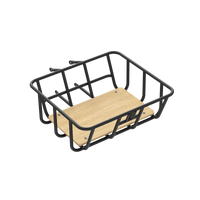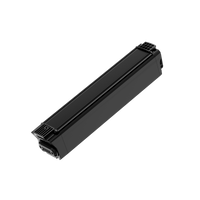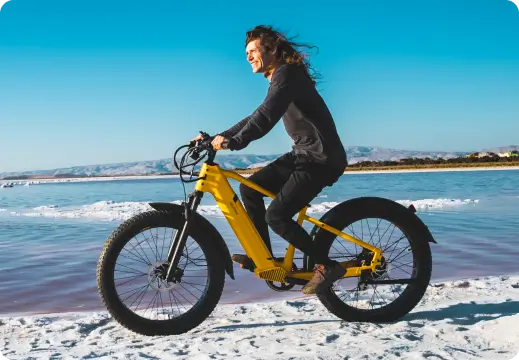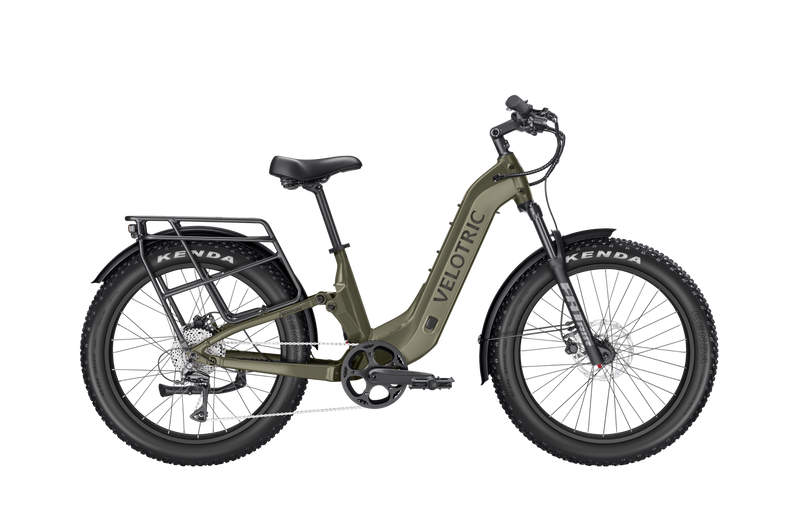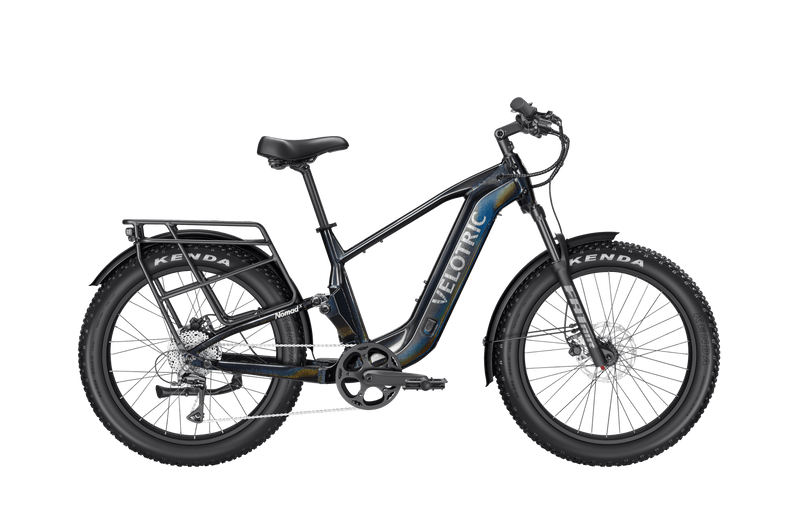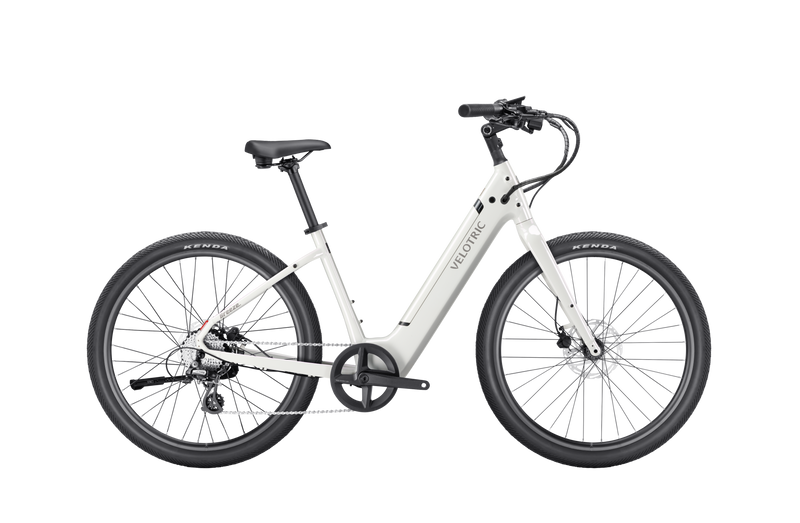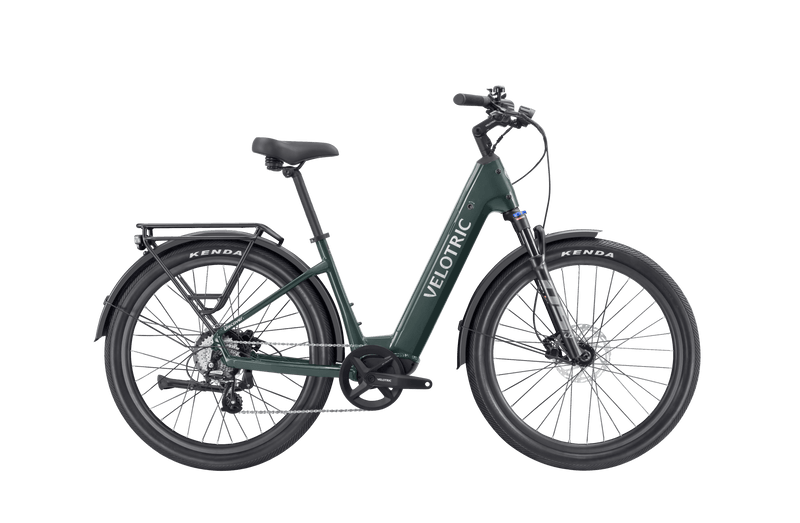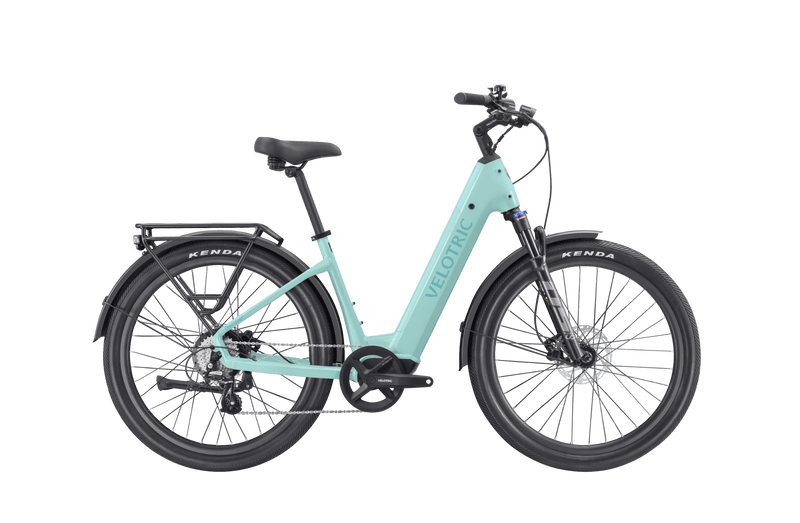If you're getting ready to buy a bike, you're probably already thinking about fun details like what color you want. But before you start dreaming about the perfect neon-green or fuschia ride, you've got to consider some technical aspects — like the type of frame you’ll choose. We hate to break it to you, but it's more important than the color!
Everyday cyclists (people who aren't BMX bikers or professional road racers) usually have either a step-over bike frame or a step-through bike frame. The type of frame you choose can impact your riding experience (we'll explain how below), so you want to choose wisely.
If you're new to cycling, the terms step-over and step-through might sound confusing. But don’t worry. We’re here to break it all down for you. Keep reading to learn the key differences between these two frame types and how to choose the one that best fits your needs.
Contents
What is a step-through bike?

A step-through bike is a bicycle designed with a low or absent top tube, making it easy for riders to mount and dismount without lifting their leg high over the frame. With a step-through frame, you can simply lift your foot and step into the bike, right behind the handlebars, so that you're straddling the frame.
Step-through bikes are popular for city riding because they allow you to get on and off quickly at stoplights, hop on with groceries or a backpack, and ride upright with ease. Their user-friendly frame makes cycling more approachable for riders of all ages and mobility levels, offering a smooth, confidence-boosting experience.
Pros and cons of step-through bikes
Think a step-through bike might be for you? These frames have a few key benefits, including the following:
✅ Pros of a step-through bike:
- Easy mounting and dismounting. The most obvious benefit of low-step frames is that they're easier to mount and dismount. You won't have to deal with hoisting your leg over the back wheel to get on.
- Kinder on your clothes. Since step-through bikes don't require you to lift a leg over the back wheel and seat to get on, they don't stress your clothes as much. They can be great if you wear skirts or dresses — or super tight pants that don't allow for an extreme leg lift. The last thing you want is to rip your pants down the middle while getting on your bike!
- Ideal for running errands. Step-through bikes are great for running errands that might require you to mount and dismount frequently. For example, if you're a delivery driver that makes a lot of stops throughout the day, you might want the ease of a step-through frame.
⚠️ Cons of a step-through bike:
Step-through bikes may be easier to mount and dismount, but they also have some disadvantages. Here are some of the cons:
- More unwieldy. Step-through bikes are missing the top frame tube of a step-over bike, which might make it seem like they should weigh less. The truth is that step-through bikes generally need to be constructed more robustly than step-over bikes — exactly because they lack this extra frame tube and the stability it offers. As a result, step-through models can be bulkier and heavier, making them unwieldy to maneuver.
- Not suitable for tough terrain. Since step-through bikes lack the stability of the extra frame tube featured in a step-over bike, they also aren't as well-suited for rough terrain. For example, if you're going to ride on unpaved surfaces, a step-over frame is definitely preferable to a step-through frame. In general, the step-through frame is better for everyday casual riding, like biking to work.
What is a step-over bike?

Step-over bikes have a diamond- or triangle-shaped frame. Also known as high-step bikes, they feature an extra frame tube that runs from below the head tube at the bike's front to the back wheel. This top tube is what creates the frame's diamond or triangle shape. In contrast, step-through bikes lack this extra frame tube.
That's the big difference between these two bike frames. While it doesn't seem like a huge deal, it plays a big part in how you get on and off the bike.
With a step-over bike, you have to hoist one foot up and over the back of the bike in order to straddle the frame and get on the seat (hence the name "step-over" — you're literally stepping over the frame to mount and dismount the bike).
Pros and cons of step-over bikes
Step-over bike frames have their own pros and cons. Here are some of their advantages:
✅ Pros of a step-over bike:
- Sturdy. The extra frame tube of the step-over bike helps stabilize the frame as a whole. As a result, step-over bikes tend to be more sturdy and durable than step-through bikes. The triangle/diamond-shaped frame results in a more robust and long-lasting bike.
- Lightweight. Step-over bikes have added stability thanks to the extra frame tube running from below the handlebars to below the seat post. As a result, they don't need to be constructed as robustly as the less stable step-over models. Step-over bikes are generally lighter, which can also make them easier to maneuver.
- Better suited for difficult terrain. The added stability of a step-over bike model also makes it better for difficult surfaces. If you're going to be riding on unpaved surfaces or inclines, a step-over frame is preferable. However, note that step-over bike frames aren't as durable as mountain bikes — if you're going to be doing serious trekking, a MTB frame is a must.
⚠️ Cons of a step-over bike:
That said, step-over bikes also have some drawbacks. Here are some of the cons to consider:
- Challenging to mount and dismount. High-step or step-over bikes may be more difficult to get on and off. Since they require you to swing a leg up and over to mount, they may not be suitable for elderly people or those with limited mobility. Limited accessibility aside, it can just be annoying to get on and off the bike, especially if you're wearing constricting clothing.
- Limited usage options. While step-over bikes are more durable than step-through bikes, they aren't a one-size-fits-all solution. For example, if you're going to be racing professionally, you want a road bike. If you want to take up BMX, you need a BMX-specific frame with the appropriate suspension and derailleur for managing jumps and extreme inclines.
Step-through vs step-over bikes: Which is better?
| Frame Type | Step-Through Bike | Step-Over Bike |
|---|---|---|
| Frame Type |
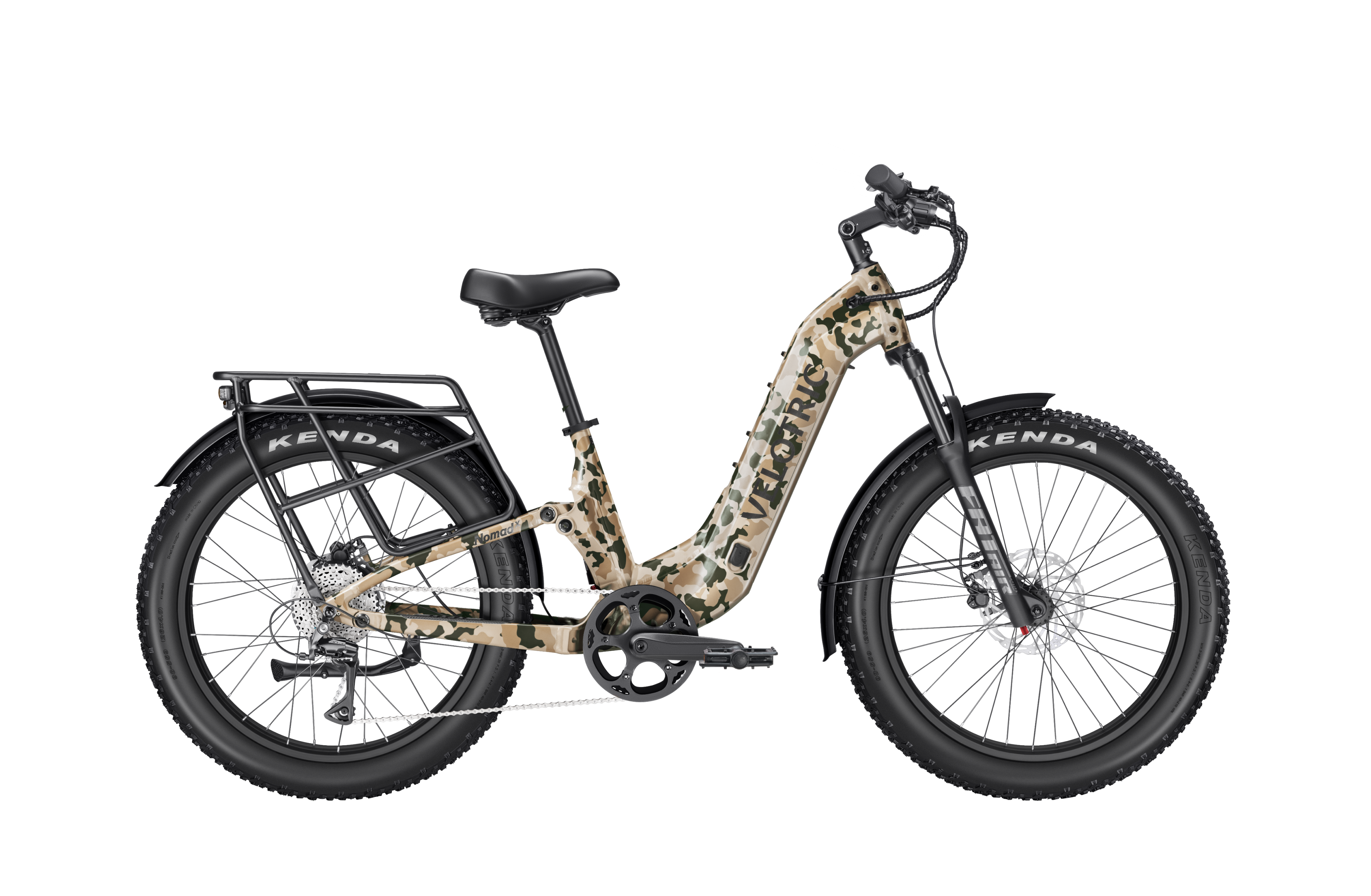 |
 |
| Frame Design | Low or no top tube for easy entry | High top tube requiring leg lift |
| Best For | Commuters, casual riders, riders with mobility concerns | Performance riders, fitness cyclists, off-road riders |
| Riding Position | Upright and relaxed | More forward-leaning and aerodynamic |
| Frame Strength | Slightly less rigid (depends on material) | Very strong and stable |
| Performance at High Speeds | Moderate; not built for aggressive riding | Excellent; designed for speed and control |
| Clothing Compatibility | Great for skirts, dresses, and everyday outfits | Best with athletic or flexible clothing |
| Terrain Suitability | Smooth city streets, bike paths | Road, gravel, trails, and varied terrain |
| Maintenance Access | Easy to handle and maneuver | Standard; depends on bike style |
| Accessory Mount Points | Sometimes fewer mounting options | Typically more accessory compatibility |
| Beginner-Friendly | Very beginner-friendly | Moderate; better for confident riders |
If you skipped down to this part of the article hoping to get a quick answer to the question of which bike frame is better, we've got news: There's no one right answer. It largely depends on your specific needs, but we can help narrow it down for you.
A step-through bike frame isn't inherently better than a step-over bike frame — and vice versa. The "best" frame for you depends on some of these personal factors:
- Size. Step-over bike frames are able to more easily accommodate taller riders. For example, Velotric's step-through bike frame is designed for cyclists from 5’1” to 6’4”, while the high-step bike frame is designed for cyclists from 5’6” all the way up to 6’9”.
- Your reason for riding. Context makes a big difference when selecting a bike frame. If you're commuting to work, you might want a step-through commuter bike frame that will be kinder to your formal attire when you're mounting and dismounting. If you're riding for exercise, you might want a step-over model that's better suited to hills — perfect for breaking a sweat! Another example: If you're using an e-bike for delivery driving, you might want a step-through frame, since you'll be getting on and off your bike a lot.
- Where you'll be riding. As mentioned, step-through frames are better suited for flat surfaces. In contrast, step-over frames can better accommodate inclines. So if you're going to be primarily riding on city roads, a step-through frame is fine — but if you plan on tackling hilly terrain, opt for a step-over frame for greater stability.
Finally, keep in mind that the bike frame alone doesn't make for the perfect fit. You need to adjust details like the seat height and handlebars to achieve the right posture (for example, a lower versus upright riding position). Find out more from our guide to bike fitting.
PS: Bike frames also differ in terms of materials. For example, there are aluminum frames, steel frames, and others to choose from. We talk more about frame materials in our comprehensive guide to bike frames.
What about Ebikes and Ebike frame designs?
Just like traditional bikes, electric bicycles can come in step-through and step-over frames. However, e-bike frames need to accommodate additional components, like the bike's battery, which is what powers the bike's motor.
The e-bike motor is what distinguishes an e-bike from a standard bike. It can power a pedal assist system (PAS), which helps power the bike forward while the cyclist is pedaling. More powerful motors can also include throttle assist functionality, in which the bike moves forward even when the cyclist isn't pedaling.
Exactly how the e-bike motor is integrated into the frame depends on the type of motor. For example, a mid-drive motor is located in the center of the frame, between the front wheels and back wheels. A hub motor is located at the back of the bike frame. You can learn more about mid-drive versus hub motors from our guide.
The general advantages and disadvantages of a step-through versus step-over frame apply to e-bikes as well — so you can still use the above list of pros and cons when selecting the right frame for your needs. Find the right frame for your riding style by scheduling a test ride!
Discover Velotric step-thru and high-step Ebikes
Now that you know the differences between step-through and step-over frames, choosing the right eBike becomes much easier. Your ideal bike should match your lifestyle—whether you’re exploring rugged outdoor trails or cruising through the city on your daily commute. Velotric offers a full lineup of high-quality eBikes built for different terrains and riding preferences, making it simple to find the perfect model for your needs.
1. Best for Outdoor Adventures: Velotric Nomad 2X (Step-Through & Step-Over)
If you’re craving adventure beyond city streets, the Velotric Nomad 2X is built for all-terrain performance. As a fat-tire electric bike, it provides outstanding traction, stability, and comfort on uneven surfaces from loose gravel to muddy trails. Its powerful motor, long-range battery, and rugged suspension make it the go-to choice for riders who love exploring the outdoors.

The Nomad 2X is available in both Step-Through and Step-Over frames, giving you flexibility based on your riding style:
- Step-Through: Easier mounting and dismounting, perfect for casual riders or anyone who wants better control when stopping frequently.
- Step-Over: More rigid and performance-oriented, ideal for aggressive, fast-paced, or highly technical off-road riding.
Whether you prefer a relaxed outdoor cruise or a challenging trail adventure, the Nomad 2X delivers power, comfort, and reliability.
Learn more about Velotric Velotric Nomad 2X
2. Best for Everyday City Riding (Step-Through): Velotric Breeze 1 – Easy, Stylish, Comfortable
For riders who prioritize comfort and convenience in a city setting, the Velotric Breeze 1 is a top pick. Its step-through cruiser-style design makes it incredibly easy to hop on and off, even in business attire or skirts. The upright geometry offers a relaxed riding posture, giving you excellent visibility and a smooth, stress-free ride through traffic, bike lanes, and neighborhood streets.

Key benefits of Breeze 1 include:
- Effortless mounting and dismounting, ideal for city stop-and-go traffic
- Comfort-focused upright position, reducing stress on your back and shoulders
- Beginner-friendly handling for new or casual riders
- Modern cruiser looks that fit perfectly into a stylish city lifestyle
If you want a comfortable, versatile, and easy-to-use eBike for daily commuting or weekend cruising, the Breeze 1 is designed with you in mind.
Learn more about Velotric Breeze 1
3. Best for Fast, Efficient City Commuting (Step-Over): Velotric T1 ST Plus – Lightweight & Performance-Driven
If you prefer a more athletic riding style and want an eBike that’s efficient, lightweight, and built for speed, the Velotric T1ST is an excellent urban companion. Its step-over frame provides extra rigidity for better power transfer, making it ideal for riders who like a fast, responsive commute.

Top advantages of the T1 ST Plus include:
- Strong and classic step-over frame designed for stability and durability
- Sportier riding position for improved speed and efficiency
- Lightweight build that makes maneuvering through city streets effortless
- Smooth, energy-efficient power system ideal for longer daily rides
For riders who value performance and a sleek, minimal city aesthetic, the T1 ST Plus delivers a powerful blend of speed, comfort, and practicality.






















